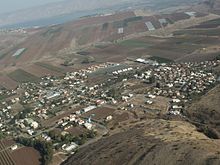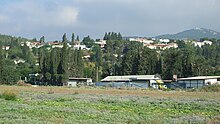Moschava
The moschava ( Hebrew מושבה, Plural מושבות Moschavot , also Moschawa ) is one of three rural forms of settlement in Israel . The better known and more common are the moshav and the kibbutz . The economy of the places is essentially based on agriculture. Unlike in moschav and kibbutz, the farmers are individual farmers with their own means of production. The land and operations are privately owned.
The moschavot is the oldest Jewish form of a rural settlement in today's Israel. The villages were usually laid out before the First World War based on the model of Central European villages. The founders were Jews who came to the country with the first or second aliyah or came from the original Jewish population, the old yishuv .
In total, significantly fewer than one hundred moschavot were founded. Cities have now developed from many moschavot. Today there are still five moschavot, all of which are in the northern district : Jabneel , Jokneam , Kinneret, Menahemia and Mitzpa.
history
In 1878, residents of Jerusalem founded Petach Tikwa, the first moschava. It was the very first Jewish agricultural settlement in what was then Palestine. That is why she later received the nickname "Mother of Moshavot" ( Em HaMoschavot ). The new foundation was abandoned because of malaria and floods.
In the first aliyah from 1882 the organization Chibbat Zion founded further moshavot. Most of the residents came from Eastern Europe, especially Russia . The second, now successful founding, now by immigrant Jews of the first Aliyah, took place in 1882 and coincided with the founding of Rishon leZion and Rosh Pina .
The first start-ups were not a success. The poor climatic conditions, the unfavorable soils, the lack of agricultural experience, the poor health and hygienic conditions (especially malaria), an inadequate infrastructure and the general hostility of the authorities of the Ottoman Empire made life in the moshavot very difficult.
Many moschavot were saved from economic collapse by the French-Jewish Baron Edmond James de Rothschild . He invested in the development of infrastructure and public services, in modern agriculture and in the processing of agricultural products. Above all, his investments in wineries became known . Baron de Rothschild also bought additional land and established new settlements. Although the moschavot managed to avoid a collapse and developed well, they paid with the loss of their independence, as the management had to be transferred to Baron de Rothschild. In January 1900 this transferred responsibility for "his villages" to the Jewish Colonization Association (ICA). With that the time of his direct guardianship came to an end. Since 1901 the ICA founded further moschavot.
The moschavot were exemplary for the beginning of Jewish settlement in Israel. They were the first to realize the ideas of the national rebirth of the Jewish people. They created the first basis for an independent Jewish life in Palestine based on agriculture, and thus for the later State of Israel. That is why they are also known as dawn .
Tables
Moschavot
Regarding the area: One acre corresponds to approx. 4047 m² .
| Surname | founding | district | Founded by | Inhabitants 1914 | Area 1914 in acre | comment |
|---|---|---|---|---|---|---|
| Atlit | 1903 | Haifa | ICA | 50 | 6800 | Is a small town today . |
| Bat Shlomo | 1889 | Tel Aviv | Baron de Rothschild | 1150 | 30,668 | Was converted into a moschav in 1951 . |
| Bet Gan | 1903 | Northern District | ICA | 100 | 4549 | Has been incorporated into Jabneel. |
| Bnei Jehuda | 1887 | Northern District | Safed residents | 50 | 3200 | Abandoned in 1913, re-established as Moschav in 1972, lies on the Golan. |
| Hadera | 1891 | Haifa district | Chibbat Zion | 450 | 31,355 | Is a city today . |
| A time im | 1892 | Northern District | Chibbat Zion | 25th | 6016 | Abandoned after the Hebron massacre in 1929 . |
| Gedera | 1884 | Central District | Chibbat Zion | 200 | 5632 | Is a city today. |
| Giv'at Ada | 1903 | Haifa district | ICA | 70 | 5000 | Is a city today . |
| Hartuv | 1895 | Jerusalem | Chibbat Zion | 75 | 4670 | Was destroyed in an Arab attack in 1929. |
| Herzlija | 1924 | Tel Aviv district | - | - | Is a city today. | |
| Jabneel | 1901 | Northern District | ICA | 300 | 24,422 | Is still a moschava today. |
| Jesud HaMa'ala | 1882 | Northern District | Chibbat Zion | 225 | 12,228 | Is a small town today . |
| Jokneam | 1935 | Northern District | - | - | Is still a moschava today. | |
| Kfar Saba | 1892 | Central District | Resident of Petach Tikva | 50 | 7231 | Is a city today. |
| Mahanajim | 1898 | Northern District | Chibbat Zion | 67 | 5657 | Abandoned in 1912, it is now a kibbutz. |
| Mas'ha | 1901 | Northern District | ICA | 200 | 16,023 | Has been called Kfar Tabor since 1903 and is now a small town . |
| Kinneret | 1908 | Northern District | ICA | 35 | 5572 | Is still a moschava today. |
| Mazkeret Batya | 1883 | Central District | Baron de Rothschild | 350 | 12,723 | Is a city today. |
| Meir Schfeja | 1889 | Haifa district | Baron de Rothschild | 128 | 8518 | Today is a youth village. |
| Menahemia | 1901 | Northern District | ICA | 200 | 9477 | Is still a moschava today. |
| Metulla | 1896 | Northern District | Baron de Rothschild | 325 | 16,907 | Is a city today. |
| Mischmar HaJarden | 1890 | Northern District | Safed residents | 125 | 7596 | Was destroyed in the Palestine War in 1948 . |
| Mitzpa | 1908 | Northern District | ICA | 50 | 3240 | Is still a moschava today. |
| Motza | 1894 | Jerusalem District | Residents of Jerusalem | 40 | 1100 | Was destroyed in an Arab attack in 1929. |
| Nahariya | 1934 | Northern District | - | - | Is a city today. | |
| Nes Ziona | 1891 | Central District | Private initiative | 200 | 2793 | Is a city today. |
| Netanya | 1929 | Central District | - | - | Today is a big city . | |
| Pardes Hanna | 1915 | Haifa district | - | - | Is a small town today | |
| Petach Tikva | 1878 | Central District | Residents of Jerusalem | 2500 | 23,837 | Today is a big city, the first moschava. |
| Qastina | 1887 | South district | Chibbat Zion | 150 | 5622 | Was partially destroyed and abandoned in an Arab attack in 1929, re-established as Moschav Be'er Tuvia in 1930. |
| Ra'anana | 1922 | Central District | - | - | Is a city today. | |
| Ramat Hasharon | 1923 | Central District | - | - | Is a city today. | |
| Rechovot | 1890 | Central District | Chibbat Zion | 800 | 14,913 | Today is a big city. |
| Rishon leTzion | 1882 | Central District | Chibbat Zion | 850 | 11,402 | Today is a big city. |
| Rosh Pina | 1882 | Northern District | Chibbat Zion | 650 | 20.102 | Is a city today. |
| Sejera | 1899 | Northern District | ICA | 200 | 17,707 | Has been converted to the Moschav Ilaniya. |
| Zichron Ya'akov | 1882 | Haifa | Chibbat Zion | 871 | 7194 | Today is a local government . |
This list does not include the five places in what is now the Syrian town of Hauran .
Today's moschavot
| Surname | founding | Local government | district | comment |
|---|---|---|---|---|
| Jabneel | 1901 | Jabneel | Northern District | |
| Jokneam | 1935 | Megiddo | Northern District | |
| Kinneret | 1908 | Emek ha-Jarden | Northern District | |
| Menahemia | 1901 | Emeq HaMa'ayanot | Northern District | |
| Mitzpa | 1908 | HaGalil HaTahton | Northern District |


